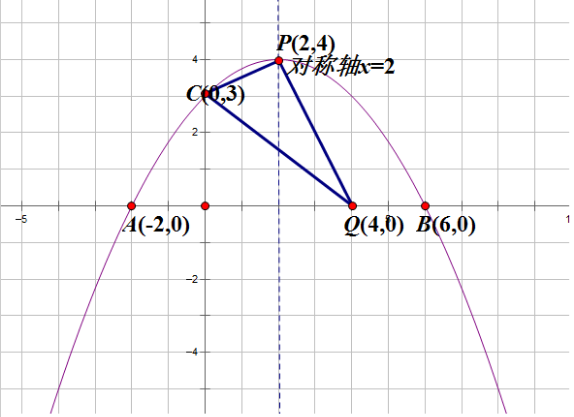$解:(2)① 由(1)知:拋物線的對稱軸為直線x=2��,頂點(diǎn)的坐標(biāo)為\left(2��,4\right)�。$
$設(shè)點(diǎn)P的坐標(biāo)為\left(2��,m\right)\left(其中0\leqslant m\leqslant 4\right)�����,$
$則P{C}^{2}={2}^{2}+(m-3{)}^{2}�,P{Q}^{2}={m}^{2}+(n-2{)}^{2},C{Q}^{2}={3}^{2}+{n}^{2}$
$\therefore PQ\bot PC$
$在Rt\triangle PCQ中��,由勾股定理得P{C}^{2}+P{Q}^{2}=C{Q}^{2},即{2}^{2}+(m-3{)}^{2}+{m}^{2}+(n-2{)}^{2}={3}^{2}+{n}^{2}$
$整理得2{m}^{2}-6m+8=4n��,即n=-\dfrac{1}{2}({m}^{2}-3m+4)=\dfrac{1}{2}{\left(m-\dfrac{3}{2}\right)}^{2}+\dfrac{7}{8}$
$\therefore m=\dfrac{3}{2}時(shí)��,n取得最小值\dfrac{7}{8}����;$
$m=4,n取得最大值4$
$故n取值范圍為\dfrac{7}{8}\leqslant n\leqslant 4$
$ $
$ $
$② 由①知:當(dāng)n取得最大值4時(shí)�����,m=4����,此時(shí)P\left(2,4\right)�,Q\left(4,0\right)$
$\therefore PC=\sqrt{5}���,PQ=2\sqrt{5}����,CQ=5$
$設(shè)點(diǎn)P到線段CQ的距離為h$
$∵{S}_{\triangle PQC}=\dfrac{1}{2}CQ\cdot h=\dfrac{1}{2}PC\cdot PQ=5$
$\therefore h=\dfrac{PC\cdot PQ}{CQ}=\dfrac{\sqrt{5}\times 2\sqrt{5}}{5}=2$
$\therefore 設(shè)點(diǎn)P到線段CQ的距離為2$

$③ 由②知:當(dāng)n取得最大值4時(shí)�,Q的坐標(biāo)為\left(4����,0\right)$
$假設(shè)CQ直線對應(yīng)的函數(shù)表達(dá)式為y=ax+b\left(a\ne 0\right)$
$將C(0����,3)����,Q\left(4,0\right)代入得\left\{\begin{array}{l}3=b\\ 0=4a+b\end{array}\right.$
$解得\left\{\begin{array}{l}a=-\dfrac{3}{4}\\ b=3\end{array}\right.$
$\therefore 直線的對應(yīng)函數(shù)表達(dá)式為y=-\dfrac{3}{4}x+3$
$不妨將線段CQ向上移t個(gè)單位后其所在直線對應(yīng)的函數(shù)表達(dá)式為y=-\dfrac{3}{4}x+3+t$
$當(dāng)線段CQ向上平移�,使點(diǎn)Q恰好在拋物線上,線段CQ與拋物線有兩個(gè)交點(diǎn)�����,此時(shí)對應(yīng)的點(diǎn){Q}_{1}的縱坐標(biāo)為-\dfrac{1}{4}\times (4+2)\times (4-6)=3$
$把{Q}_{1}(4�����,3)代入y=-\dfrac{3}{4}x+3+t���,得t=3��;$
$當(dāng)線段CQ繼續(xù)向上平移��,線段CQ與拋物線只有一個(gè)交點(diǎn)時(shí)�,聯(lián)立\left\{\begin{array}{l}y=-\dfrac{1}{4}\times (x+2)\left(x-6\right)\\ y=-\dfrac{3}{4}x+3+t\end{array}\right.得{x}^{2}-7x+4t=0$
$由根的判別式^{2}-4ac={\left(-7\right)}^{2}-4\times 1\times 4t=49-16t=0���,得t=\dfrac{49}{16}$
$綜上所述���,當(dāng)線段CQ與拋物線有兩個(gè)交點(diǎn)時(shí),t的取值范圍為3\leqslant t\leqslant \dfrac{49}{16}�����。$
$ $